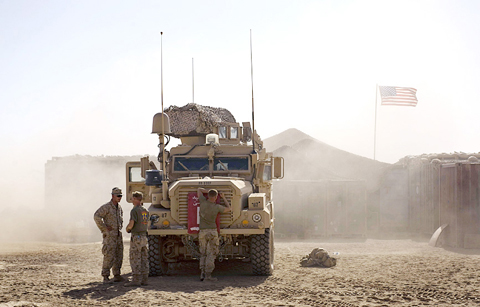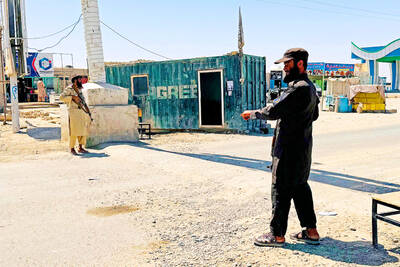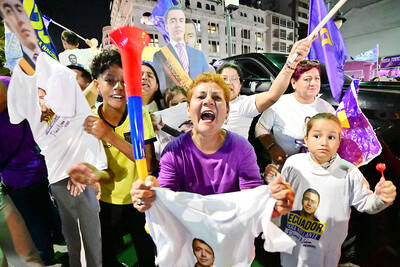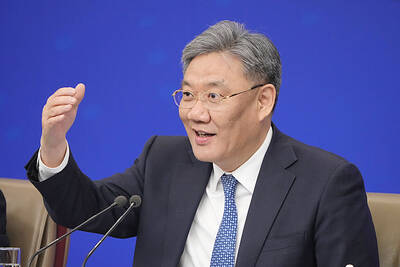A new wave of US Marines sent to Afghanistan by US President Barack Obama to turn the table on Taliban insurgents is in position and ready for action, the military has said.
About 10,000 fighters of the Second Marine Expeditionary Brigade have arrived in Helmand, an opium-growing southern province where the Taliban have widespread power despite being ousted from government by US-led forces in 2001.
“All the Marines being deployed have now got here,” Lieutenant Abe Sipe, spokesman for the brigade, said on Friday. “Our overall troop number is 10,700, of which 7,000 are at Camp Leatherneck and about 3,000 elsewhere in Helmand. These Marines form the major part of the US troop increase.”

PHOTO: AFP
A total of 17,000 US troops and 4,000 military trainers have been pledged for Afghanistan as part of Obama’s new strategy to defeat the Islamist Taliban, who have been gaining in strength over the past few years.
A Combat Aviation Brigade was the first to deploy, moving into the southern province of Kandahar by the middle of last month. A Stryker Brigade Combat Team is also heading in to complete the fighting reinforcements.
Camp Leatherneck is a collection of tents and cabins that has sprung out of the flat desert of central Helmand to accommodate Marines, who are at the spearhead of what has been dubbed the “Afghanistan surge.”
But the Marines’ commander rejected the surge tag, saying the influx was not an attempt to replicate the successes of the 2007-2008 surge of US troops into Iraq.
“We don’t use the term. It is a word for Iraq,” General Larry Nicholson told reporters in a brief interview. “There is no end date for us here.”
The plan combines the “hard power” of boosted US troop numbers with a major effort to improve the Afghan army and police force, and an emphasis on neighboring Pakistan’s role in region.
The Marines in Helmand are expected to move south in the coming weeks ahead of presidential elections scheduled for Aug. 20.
The Dutch commander for southern Afghanistan said on Thursday that the NATO-led forces were seizing the initiative against insurgents.
Major-General Mart de Kruif, who oversees more than 30,000 international troops, said the force was “now entering a new stage, in which we will have the operational initiatives on our side and maintain it.”
With the influx of US Marines and Army combat troops, “significant operations” would be launched “in a very short time” in Helmand province and the city of Kandahar, he said.
One of the concerns for the military is a feared rise in attacks in the run-up to the presidential elections as the insurgents try to destabilize an internationally funded drive for democracy.
“One of the goals of establishing a presence here is to instill a reality that this province is stable enough to hold meaningful elections,” Sipe said.
But elections were just one factor in the Marines’ battle plan for the summer, he said.
“The overall mission of the brigade here is to secure Helmand province in co-operation with Afghan national security forces,” he said.
Parts of Helmand, which borders Pakistan in the south, are firmly in Taliban hands and the region provides much of the heroin that funds the insurgents.
The international military warned this month that violence in the country, and Helmand in particular, had reached record highs.
NATO’s International Security Assistance Force (ISAF) said insurgent-initiated attacks from January until last month across Afghanistan were about 60 percent higher than those for the same period last year.
And Helmand was “in particular experiencing the highest increase,” an ISAF spokesman said.

‘EYE FOR AN EYE’: Two of the men were shot by a male relative of the victims, whose families turned down the opportunity to offer them amnesty, the Supreme Court said Four men were yesterday publicly executed in Afghanistan, the Supreme Court said, the highest number of executions to be carried out in one day since the Taliban’s return to power. The executions in three separate provinces brought to 10 the number of men publicly put to death since 2021, according to an Agence France-Presse tally. Public executions were common during the Taliban’s first rule from 1996 to 2001, with most of them carried out publicly in sports stadiums. Two men were shot around six or seven times by a male relative of the victims in front of spectators in Qala-i-Naw, the center

Incumbent Ecuadoran President Daniel Noboa on Sunday claimed a runaway victory in the nation’s presidential election, after voters endorsed the young leader’s “iron fist” approach to rampant cartel violence. With more than 90 percent of the votes counted, the National Election Council said Noboa had an unassailable 12-point lead over his leftist rival Luisa Gonzalez. Official results showed Noboa with 56 percent of the vote, against Gonzalez’s 44 percent — a far bigger winning margin than expected after a virtual tie in the first round. Speaking to jubilant supporters in his hometown of Olon, the 37-year-old president claimed a “historic victory.” “A huge hug

Canadian Prime Minister Mark Carney is leaning into his banking background as his country fights a trade war with the US, but his financial ties have also made him a target for conspiracy theories. Incorporating tropes familiar to followers of the far-right QAnon movement, conspiratorial social media posts about the Liberal leader have surged ahead of the country’s April 28 election. Posts range from false claims he recited a “satanic chant” at a campaign event to artificial intelligence (AI)-generated images of him in a pool with convicted sex offender Jeffrey Epstein. “He’s the ideal person to be targeted here, for sure, due to

DISPUTE: Beijing seeks global support against Trump’s tariffs, but many governments remain hesitant to align, including India, ASEAN countries and Australia China is reaching out to other nations as the US layers on more tariffs, in what appears to be an attempt by Beijing to form a united front to compel Washington to retreat. Days into the effort, it is meeting only partial success from countries unwilling to ally with the main target of US President Donald Trump’s trade war. Facing the cratering of global markets, Trump on Wednesday backed off his tariffs on most nations for 90 days, saying countries were lining up to negotiate more favorable conditions. China has refused to seek talks, saying the US was insincere and that it